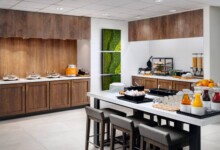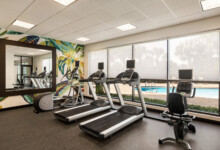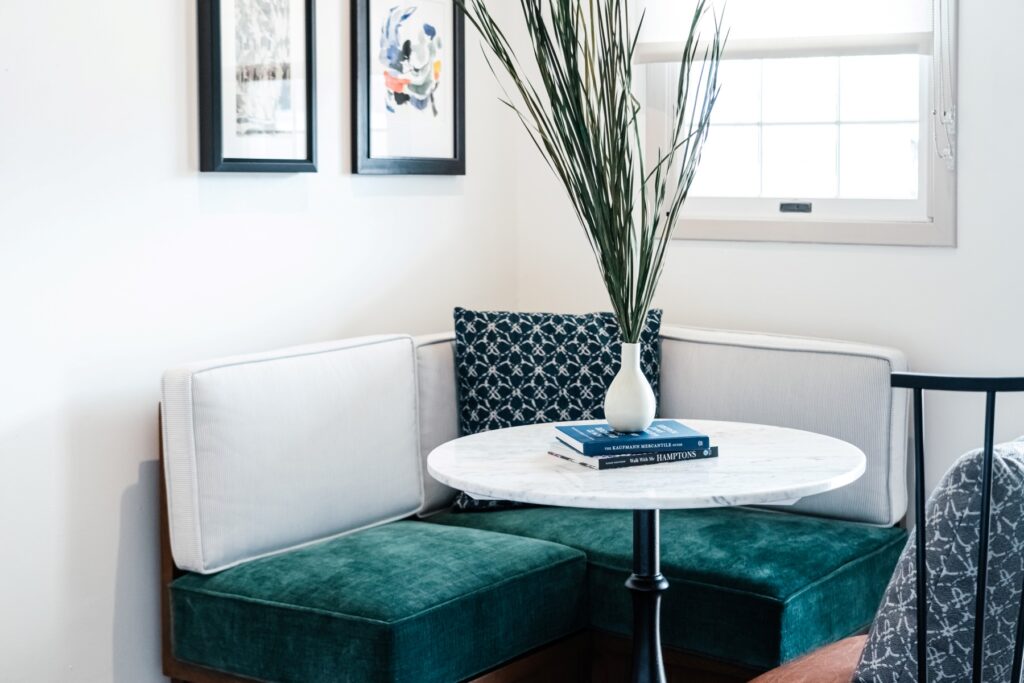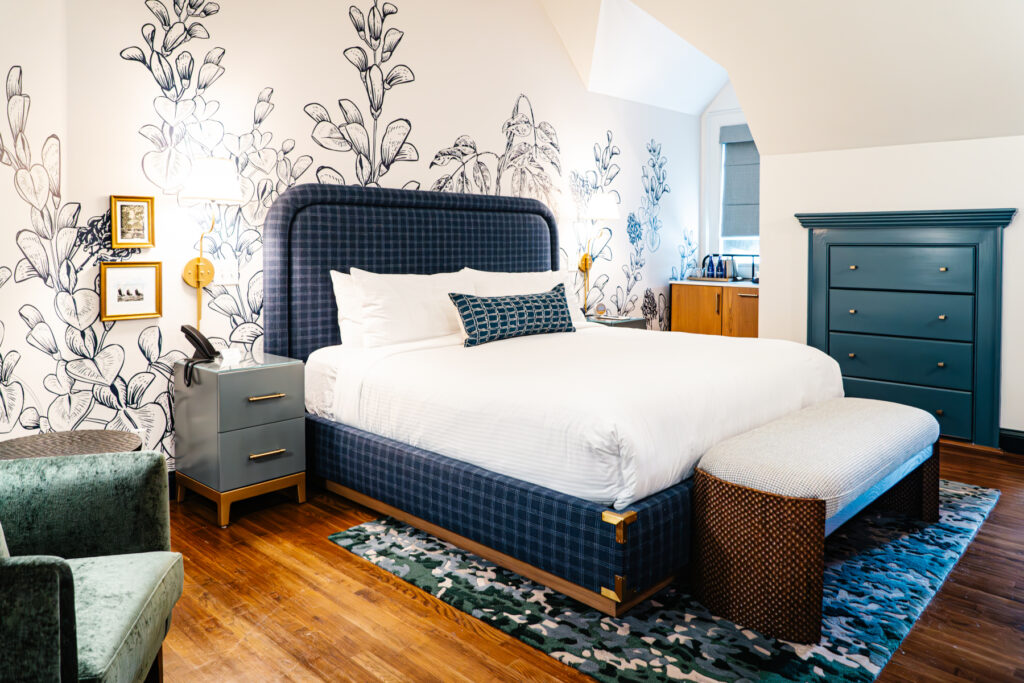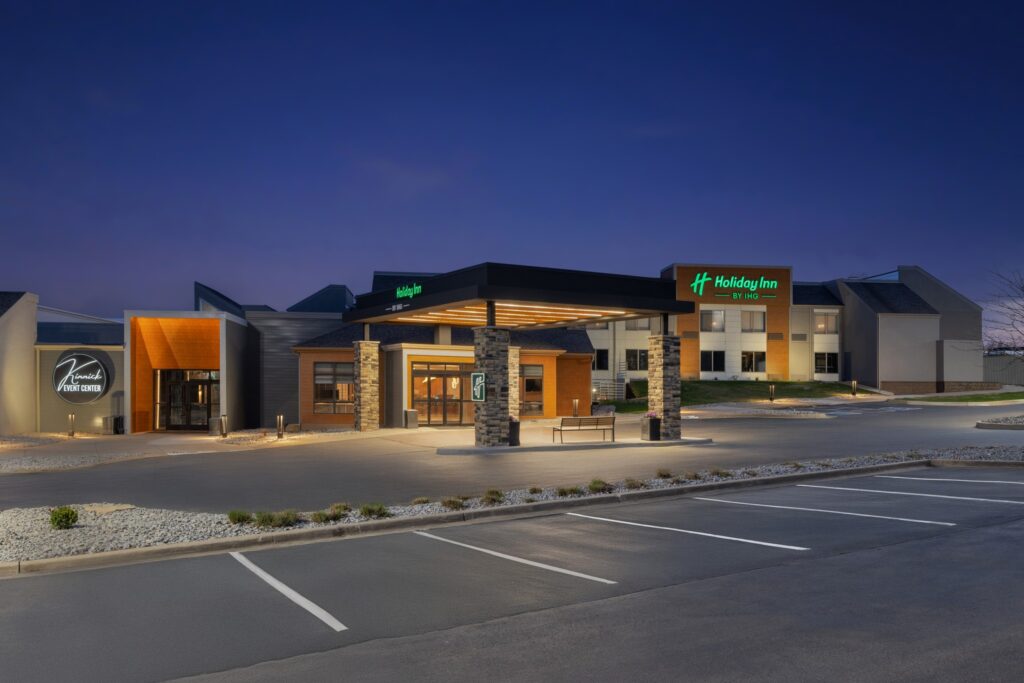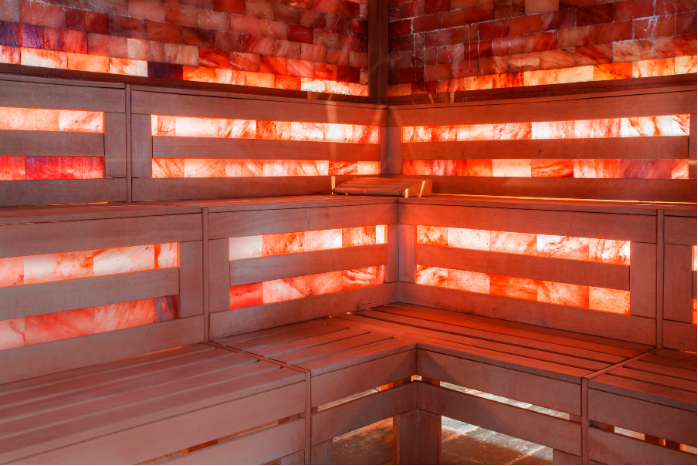Ultimate Guide to Hotel Design Trends 2026
It’s been one year since we released our 25 hotel design trends for 2025 and we’re back to bring you our slightly smaller but just as comprehensive list of hotel design trends for 2026. While we aren’t making you read 26 trends this year (phew), we have pulled together the top 10 being spotted by us and a couple of industry’s leaders in design.
Some trends are popping up everywhere, and others depend on the property type, whether it’s select service, full service, boutique, or luxury we’ve got you covered. From authentic stays, bleisure, and tech to adaptive reuse and the buzzword we can’t get enough of (storytelling) we’re providing you with an in depth look at what trends are here, what’s coming, and what we’re saying goodbye to in 2026.
Follow along with us as we delve into each of these hotel design trends (along with a few more of our favorites) in our 2026 hotel design trends report.
Contents:
- Importance of Hotel Design Trends
- Across the Board (General Trends)
- Top 10 Hotel Design Trends for 2026
- What Trends We’re Leaving Behind
- Looking Forward (Future Hotel Design Trends)
- Our Musings
- Conclusion
- Preview of our Q&A with IIG & Throughline on 2026 Design Trends
The Importance of Hotel Design Trends: How to Stay Competitive in 2026 and Beyond
Understanding hotel design trends isn’t just about staying current—it’s about staying competitive. Guest expectations evolve quickly, and design plays a major role in how travelers perceive value, comfort, and experience.
When owners and operators stay ahead of emerging trends, they’re able to plan more strategically, budget more accurately, and incorporate updates that meet both brand standards and guest demands. Design trends also influence long-term ROI, impacting everything from guest satisfaction scores to ADR and occupancy.
In an industry where first impressions matter and renovation cycles are constant, knowing where design is headed helps hotels make smarter decisions today that prepare them for tomorrow.
Saving reports and guides like our Hotel Design Trends 2026 will help you stay competitive and spark ideas for your next renovation.
Across the Board (General Trends):
While some hotel design trends can be specific to the type of hotel or brand, there are also a few that span most brands and hotel types.
Here are some we’re seeing in renovations and expect to see more of in 2026:
- PIPs seem to be becoming more lenient with their exterior requirements.
- We have noticed an uptick in ownerships looking at conversions as well as deferred PIP’s over the last 6-12 months.
- Getting guests into revenue driving areas of the hotel seems to be a main design driver. – Sharon Bilbeisi – SVP of Design at IIG
- Sustainability & authenticity are the expectation not the trend.
- Wellness & tech aren’t just here to stay, they are growing and expanding.
Top 10 Hotel Design Trends for 2026
1. Wellness & Sustainability
Wellness has evolved from a niche amenity into a core expectation. Today’s travelers want hotels that support balance, mindfulness, and healthy living, and owners who respond to this shift are seeing stronger satisfaction, repeat business, and differentiation in competitive markets.
Across PIPs and projects, owners are prioritizing:
- Wellness Amenities Expansion: Bigger fitness centers, spa-like bathrooms with rain showerheads, soaking tubs with jets, steam rooms, and cold plunges elevate the guest experience.
- Natural & Biophilic Environments: Natural lighting, indoor/outdoor connections, and nature-inspired palettes with earth tones and jewel accents support mental and physical wellness.
- Sustainable & Authentic Materials: Organic textures, reclaimed or repurposed stone, wood, and recycled composites create character while prioritizing sustainability.
- Social & Flexible Spaces: Adaptable indoor/outdoor lounges with TVs, heaters, sinks, and retractable screens encourage community, relaxation, and engagement.
- Wellness-Focused Dining & Beverage: Mocktails, kombucha taps, and plant-based options reinforce the holistic wellness experience.
- Staff Wellbeing Design: Back-of-house areas are designed with natural light and inclusive break spaces to support employees and create a healthier work environment.
- Art & Eco Integration: Nature-inspired artwork, low-VOC paints, eco-friendly materials, and energy-efficient fixtures strengthen both aesthetic and environmental value.
- Boutique & Repurposed Furniture: Using reclaimed or second-hand furniture adds personality, reduces environmental impact, and enhances boutique hotel storytelling.
Social wellness experiences, including classes and events, are becoming part of the guest expectation, alongside spaces designed to support mental and physical health. Biophilia is a central approach, connecting guests to nature through colors, materials, and views while supporting operational efficiency and sustainability.
Operational and Owner Value: Wellness spaces are not just amenities – they’re a revenue opportunity. Communal wellness areas can drive F&B spend, increase foot traffic, and support retention. Designers also note that wellness-first design helps with brand differentiation and appeals strongly to repeat, health-minded travelers.
2. Smart & Embedded Tech
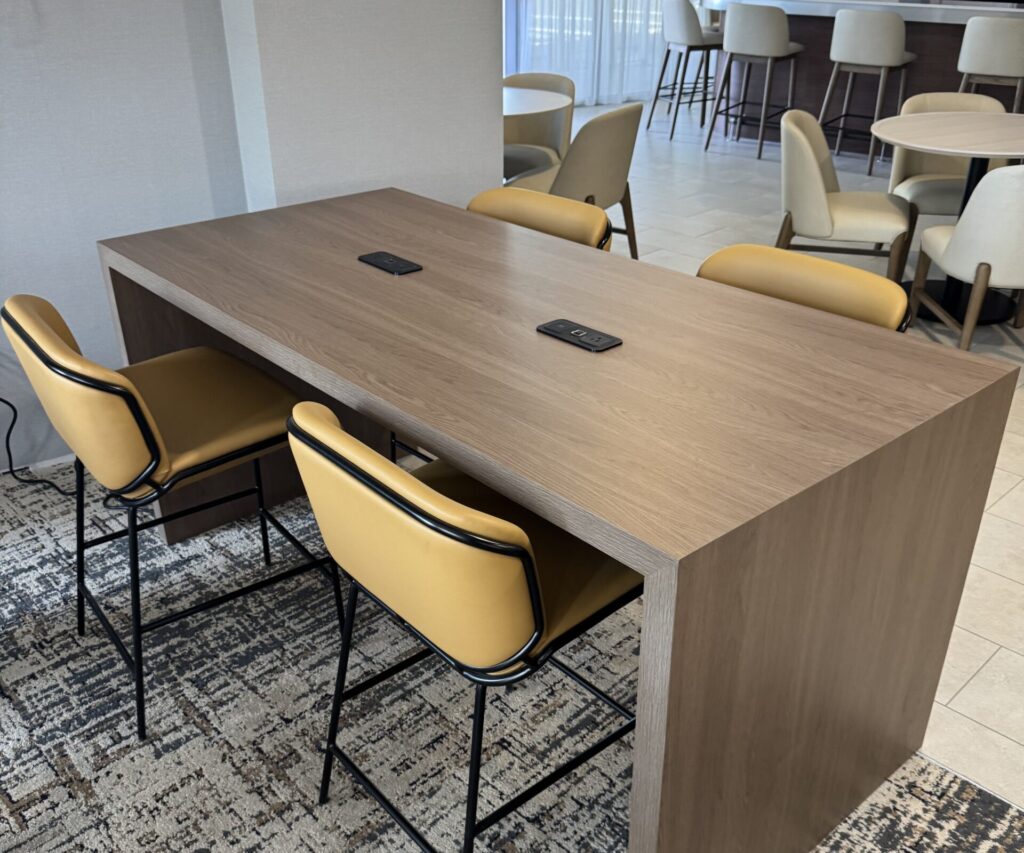
Hoilday Inn | Boise, ID
Technology continues to shape guest expectations and hotel renovations. Today’s travelers want convenience, control, and personalization, and owners who invest thoughtfully in tech can enhance the guest experience while supporting long-term value.
Across the PIPs and projects we are fulfilling, hotels are prioritizing in-room and public-space technology that is intuitive and meaningful.
Guests are increasingly expecting:
- Cordless charging pads built into ff&e
- Mobile controlled AC, heat, lighting, and window shades
- Heated or lighted toilets and bathroom floors
- USB-C and fast-charging outlets in rooms and social spaces
- Digital check-in and mobile keys
- Robot butlers
These upgrades allow guests to tailor their stay to their preferences and support productivity, comfort, and connectivity.
Hotels are also leveraging technology behind the scenes to improve efficiency, sustainability, and security with solutions like energy-management systems, smart thermostats, and occupancy sensors.
Why It Matters to Owners: By focusing on technology that adds real value, owners can meet guest expectations, improve operations, and avoid costly, short-lived trends.
3. Bleisure

Hilton Garden Inn | Palm Coast, FL
“Bleisure” is no longer a niche, it’s a core expectation. The modern traveler wants a seamless blend of work and rest.
Design implications include:
- Flexible Work Zones: Guestrooms & public areas with work nooks, convertible furniture, and ergonomic surfaces that don’t feel corporate.
- Adaptable Public Spaces: Lobbies, lounges, and F&B areas that accommodate everything from remote work to evening social events.
- Furniture & Layout Strategy: Modular, moveable, conversational and designed to support lounging, meeting, and working in the same space.
- Lighting & Technology Considerations: Work areas with task lighting, smart plugs, and power access blend into relaxing corners without visual division.
Value for Owners: By designing with bleisure in mind, hotels can increase utilization of public space, boost food and beverage spend, and appeal to both business and leisure travelers in one go.
4. Boutique, Unique, & Homey
Design is becoming more personalized, residential, and emotionally resonant. Guests want to feel connected to a space, they crave individuality and experiences they can share. Creating inspirational spaces that are unique to your hotel and provide Instagram worthy material for guests can help owners retain and gain travelers.
What we’re seeing:
- Modular, Adaptable Furniture: Pieces that support work, rest, and socializing within the same space.
- Local Materials & Art: A focus on community craftsmanship, local textures, and design storytelling.
- Personalization: From in-room climate and lighting control to smart TVs that display a guest’s name, hotels are tailoring stays.
- Emotional Design: Creative color palettes, meaningful textures, and design touches that make a space feel like a personal retreat.
Owner Value: Personalized boutique design helps create guest loyalty, supports premium pricing, and builds a strong identity for soft brand or independent hotels.
5. Human-Centric, Authentic & Story-Driven Design:
Guests are craving more than a place to sleep – they want emotional connection, meaning, and places that tell a story.
What we’re seeing:
- Authenticity as a Baseline: Authenticity in design has shifted from optional to essential, with hotels embracing local materials, regional art, and compelling stories.
- Emotional Design: Alissa Ponchione (Executive Editor Hospitality Design Magazine) talks about “human-centric” spaces: environments shaped by how people feel, not just how they look.
- Soft Brand Storytelling: Boutique and soft brands are diving deeper into narratives (community relationships, heritage, sustainability impact) and using design to express that.
- Inclusive & Personalized Environments: Spaces designed to make all guests feel welcome: inclusive programming, localized design, and emotional resonance.
Owner Perspective: Story-driven design helps differentiate a property, builds loyalty, and supports premium positioning. Investing in authenticity can pay off in both guest satisfaction and brand equity.
6. Flexible & Adaptable Spaces
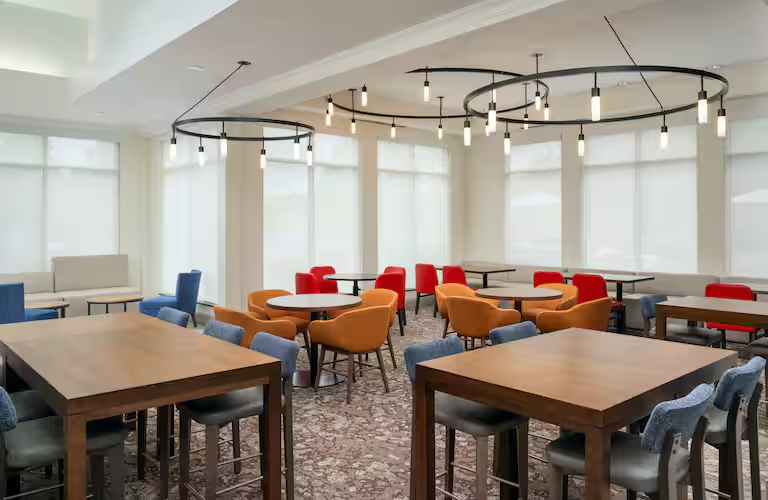
Hilton Garden Inn | Huntsville, AL
Adaptability is not optional, it’s strategic.
Key design moves:
Modular Layouts: Moveable walls, modular furniture, and multipurpose areas allow for more flexible use of space.
Personalized Rooms: Guests want control – lighting, climate, layouts, and even digital personal touches (like a TV that recognizes their name) are in demand.
Flexible Public Areas: Spaces that shift from coworking to lounge to event mode, depending on time of day and guest needs.
Why It’s Important: Flexible design minimizes wasted space, maximizes ROI on square footage, and allows hotels to adapt quickly to changing guest behaviors or business models.
7. Adaptive Reuse
Repurposing existing buildings and spaces continues to be a smart and sustainable design strategy. One of our projects comes to mind where we converted an underused pavilion space into a new-build fitness center that overlooked the pool. This new addition to the Courtyard in Palm Springs, CA will now appeal to those seeking wellness stays.
What we’re seeing:
- Conversion Projects: Former retail locations, schools, or office buildings are prime candidates for hotel conversion.
- High-Traffic Locations: These properties often come with existing parking and foot traffic, which reduces development risk.
- Character-Rich Spaces: Historic or underused structures offer design opportunities that feel unique, story-driven, and authentic.
Owner Benefits: Adaptive reuse often means lower construction costs, reduced environmental impact, and a strong narrative — all of which add to long-term asset value.
8. Loud Luxury & Maximalism:
The “more is more” design aesthetic is making a strong comeback — but with purpose.
Trend details:
- Bold Materials & Patterns: Colorful tiles, patterned backsplashes, hidden cabinets, and mixed finishes are resurfacing.
- Paying Homage to Craftsmanship: Statement hardware and custom cabinetry emphasize artisanal quality.
- Maximalism + Wellness: Designers are blending opulence with calm — think bold textures balanced with natural, soothing materials.
Owner Impact: Maximalism allows for strong brand differentiation. Bold, well-curated spaces can become destination experiences, enhancing both guest delight and social media appeal.
9. Maximizing Profitability of Space & Brand
Design is becoming a direct driver of revenue, not just aesthetics.
Key components:
- Revenue-Driving Public Spaces: Lobbies blended with F&B, bars, and social spaces to encourage guest flow into spend zones.
- Branded Lifestyle Extensions: More hotels are exploring branded residences, yacht experiences, or member-only floors. Alissa Ponchione Executive Editor at Hospitality Design notes that brands are expanding beyond traditional hotel stays into “work, eat, play” community anchors.
- Third Spaces: Exclusive lounges, coworking hubs, or private club areas that anchor the guest experience and create recurring traffic.
Why Owners Care: These strategies create diversified income streams, increase guest engagement, and support long-term loyalty. Design becomes a lever for profitability.
10. Mixed-Use & Hybrid Models:
Hotels are no longer just places to sleep — they are becoming lifestyle hubs.
Key ideas:
- Integrated Uses: Work, social, living, and leisure functions blended within the same property.
- Dual-Concept Spaces: Multi-purpose F&B venues that shift mode throughout the day (e.g., cafe by day, bar by night).
- Branded Residences & Community Ties: Branded living options, exclusive floors or lifestyle memberships that deepen guest and local engagement.
Why It Matters: Mixed-use maximizes ROI by diversifying revenue streams. It also supports a brand’s expansion into lifestyle, membership, and real estate without duplicating infrastructure.
What Hotel Design Trends We’re Leaving Behind:
- All-White & Millennial Gray Interiors: These neutral palettes are fading. Design is returning to warmth, texture, and boldness. People flourish in colorful spaces.
- Sterile, Corporate Spaces: Work and social areas that feel cold or transactional are being replaced by flexible, emotionally resonant environments.
- Cookie-Cutter Design: Standardized interiors with no character are falling out of favor. Guests want personality, story, and meaning.
Looking Forward to 2027 Hotel Design Trends & Beyond:
Based off of what we’re seeing in the industry, conversations with designers, our own research, and more we’ve compiled a list of trends we believe we will see in the future of hotel design:
- Sensory & Inclusive Spaces: Silent pods, neurodivergent-friendly rooms, salt or lavender wellness rooms, and emotion-design-forward spaces.
- Expandable & Adaptive Design: More modular, function-shifting public and private spaces.
- Wellness Meets Healthcare: Deeper integration of mental wellness, spa, and health spaces. Think in-hotel retreats, recovery lounges, and meditative zones.
- Regenerative Sustainability: Green roofs, rain gardens, subterranean living, circular-material systems, and local reuse partnerships.
- Branded Lifestyle Expansion: More branded residences, hotels on yachts, and mixed-lifestyle properties.
- AI, Tech, and Prototyping: Advanced intelligent systems, voice control, predictive maintenance, and early-stage collaboration between design and owners.
Our Musings:
- Bathtubs are traditionally associated with relaxation and wellness. It’s worth questioning why they are being removed from many hotel rooms, especially as wellness becomes a central design focus.
- Psychology and science will increasingly influence design, helping hotels create environments that impact mood, behavior, and overall guest experience through design.
- Don’t overlook the exterior. First impressions matter. If two similar hotels are side by side, guests are more likely to choose the one with a fresh, modern exterior. A contemporary exterior signals cleaner, more modern rooms, updated amenities, and better service. Perception plays a major role – guests may choose a “nicer-looking” hotel at the same price because they want the experience and status associated with it.
Conclusion:
Hotel design in 2026 focuses on creating thoughtful, memorable experiences. Wellness, flexible spaces, technology, and storytelling are shaping guest expectations, while traditional approaches are evolving to include more warmth, texture, and authenticity.
For owners, understanding these trends can add real value. Thoughtful design encourages guests to engage with public spaces, wellness areas, and amenities, creating opportunities for increased revenue and stronger brand identity. It also helps properties stand out in competitive markets and appeal to experience-driven travelers.
Applying these insights in renovations or new projects helps owners plan strategically, manage budgets wisely, and drive long-term ROI. From first impressions on the exterior to thoughtful interior details, design enhances guest satisfaction and overall property performance.
Preview of our Q&A with IIG & Throughline on 2026 Design Trends:
Q: What’s one design risk you think is worth taking (and one risk to avoid)?
A:
Worth it: Approaching things with a bit of playful humor. Artwork that pushes the envelope. Lightheartedness. Purchasing fun art, enjoying life, and approaching design with edginess and humor—tongue-in-cheek elements that younger generations will appreciate. – Sharon Bilbeisi, SVP of Design at IIG
Not worth it: Using new materials whose durability or quality is unknown. Some things simply aren’t made for commercial use, and the wear and tear in hospitality is heavier.
Q: Are there any design trends you want to go away? What would replace them?
A:
“Tariffs (lol), but really—releasing the idea of the TV as a focal point in the lobby. It’s rarely used anymore and makes more sense in a bar space if anything.”
Instagrammable spaces or spaces designed to generate revenue will replace these areas. – Sharon Bilbeisi, SVP of Design at IIG
Be on the lookout for our full interview with IIG and Throughline, and subscribe to our newsletter to get the latest insights straight to your inbox. Click Here



